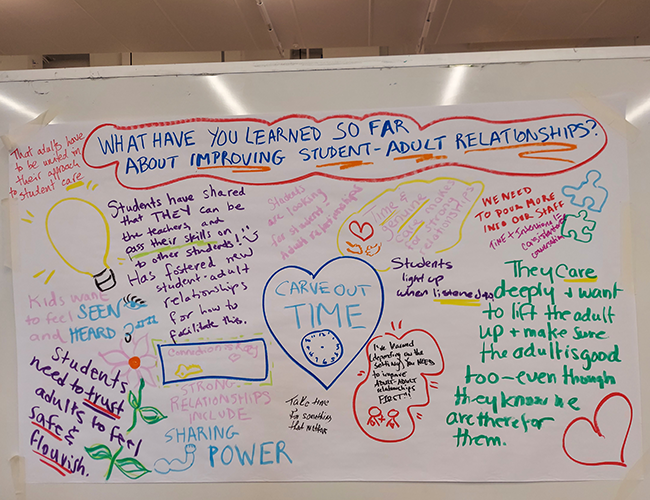Blog
Elevating Student Voice to Strengthen Developmental Relationships
Students thrive when they are empowered and involved in their classrooms and schools. However, too few of them report having meaningful opportunities to participate in and influence decision-making in their educational environment. Additionally, many young people report they have little say in how decisions are made in their schools and classrooms.
A growing body of research shows the importance of promoting student voice by including young people in the decision-making processes in classrooms and schools. Student voice practices foster environments where young people can become more empowered to influence their own paths to acquire knowledge.
What are the practices that educators can use to foster active engagement in the school community?
What Is Student Voice?
Student voice refers to the opportunities young people have to participate in and influence the educational decisions that shape their lives. Sharing power with young people creates a culture of student voice—where young people’s ideas are both taken seriously and implemented with the support of caring adults. Sharing power in a developmental relationship involves these four key actions.
- Respect me. Take me seriously and treat me fairly.
- Include me. Involve me in decisions that affect me.
- Collaborate. Work with me to solve problems and reach goals.
- Let me lead. Create opportunities for me to take action and lead.
At its heart, sharing power creates an environment where student voice can happen. It highlights the ways we influence, learn from, and work with each other through our relationships and enables young people to learn, and thrive.
Search Institute developed a Student Voice Framework that uses research-backed measures to understand and assess the level of student voice within a classroom or schoolwide setting. The framework can be used to guide educators through the development or refinement of a student voice practice (SVP) in their classrooms and schools. When developing or refining an SVP, educators should consider their decisions within the framework’s elements both individually and collectively.
Implementing Student Voice Practices
There are many ways to engage students in making their learning environments more responsive to their needs. Student voice practices can take many forms and can occur in many settings.
Committed to bringing actionable knowledge based on scientific research, Search Institute collaborated on the Student Voice to Student Outcomes study–funded by the Bill & Melinda Gates Foundation–to build evidence of the value of student voice in moving the needle on critical student outcomes and in creating more equitable learning environments. Search Institute’s Student Voice Toolkit is one of the products of this study. The toolkit includes a set of tools educators can use to advance their school’s student voice practices.
Here are just a few of the ways educators can promote student voice in their classrooms:
- They can recruit students in pedagogical partnerships to improve learning.
- They can survey their students for critical feedback on the effectiveness of assignments and assessments.
- They can promote dialogue with groups of students to create shared learning experiences open to diverse inputs.
Student voice practices (SVPs) can help schools address systemic inequities that disproportionately affect students from historically marginalized groups. When students can collaborate with adults to improve their learning environments, the results are more equitable practices at both school and classroom levels.
When students engage in SVPs, they students build critical competencies (e.g., social awareness, responsible decision-making, agency, self and social advocacy), which, in turn, positively shift their own life trajectories.
Challenges of Implementation
There are many potential challenges to implementing student voice practices in schools. Instructors may not be accustomed to giving students the necessary control over classroom activities and schedules. Students themselves may not be emotionally prepared to contribute if they have never before had the opportunity. Structural arrangements and sociocultural conditions may not be adapted to accommodate SVPs.
To address the challenges of bringing student voice into their own learning environments, educators and administrators can ask themselves these questions:
- Do your school and your classroom now use effective student voice practices?
- Is there a healthy mindset for taking advantage of opportunities to leverage student voice to enrich the learning experience for all young people?
- Are there attitudes that need to change?
- What other barriers may exist in your learning environments to embracing student voice practices?
- What actions can you take now to begin to support more effective use of student voice?
Major Approaches
In the classroom, there are two main ways to incorporate student voice practices. The first involves seeking student feedback and input on the classroom experience. This can be achieved with various types of surveys, discussions, or more creative activities such as skits and role-playing.
The second approach to elevating student voice involves engaging students in decision-making on curriculum, pedagogy, and other aspect of the learning experience. These practices can involve working with students individually or in groups to collaborate with their instructors on how they will engage with the curriculum and try to bring it to life in their own contexts.
Tools for Implementing Student Voice Practices
We encourage you to review the Student Voice Toolkit, use the activities, and take the assessments to better understand and reflect on the state of student voice practices in your school and identify opportunities for deepening your commitment to student voice.



